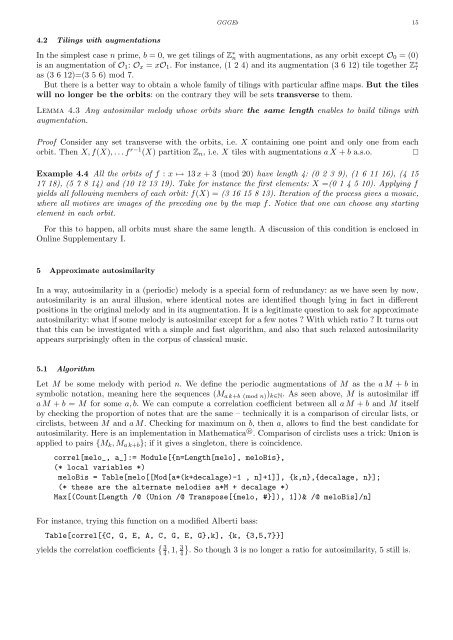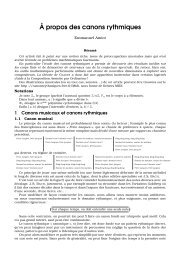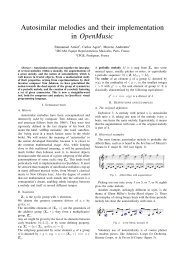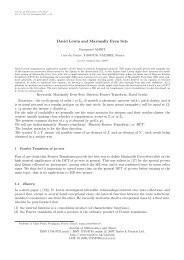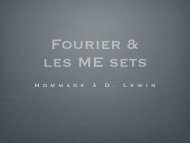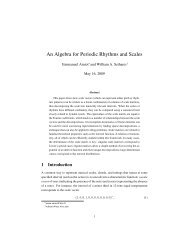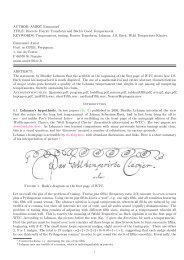Emmanuel Amiot Modèles algébriques et algorithmes pour la ...
Emmanuel Amiot Modèles algébriques et algorithmes pour la ...
Emmanuel Amiot Modèles algébriques et algorithmes pour la ...
You also want an ePaper? Increase the reach of your titles
YUMPU automatically turns print PDFs into web optimized ePapers that Google loves.
4.2 Tilings with augmentations<br />
GGGE♭ 15<br />
In the simplest case n prime, b = 0, we g<strong>et</strong> tilings of Z ∗ n with augmentations, as any orbit except O0 = (0)<br />
is an augmentation of O1: Ox = xO1. For instance, (1 2 4) and its augmentation (3 6 12) tile tog<strong>et</strong>her Z ∗ 7<br />
as (3 6 12)=(3 5 6) mod 7.<br />
But there is a b<strong>et</strong>ter way to obtain a whole family of tilings with particu<strong>la</strong>r affine maps. But the tiles<br />
will no longer be the orbits: on the contrary they will be s<strong>et</strong>s transverse to them.<br />
Lemma 4.3 Any autosimi<strong>la</strong>r melody whose orbits share the same length enables to build tilings with<br />
augmentation.<br />
Proof Consider any s<strong>et</strong> transverse with the orbits, i.e. X containing one point and only one from each<br />
orbit. Then X, f(X), . . . f r−1 (X) partition Zn, i.e. X tiles with augmentations a X + b a.s.o. <br />
Example 4.4 All the orbits of f : x ↦→ 13 x + 3 (mod 20) have length 4: (0 2 3 9), (1 6 11 16), (4 15<br />
17 18), (5 7 8 14) and (10 12 13 19). Take for instance the first elements: X =(0 1 4 5 10). Applying f<br />
yields all following members of each orbit: f(X) = (3 16 15 8 13). Iteration of the process gives a mosaic,<br />
where all motives are images of the preceding one by the map f. Notice that one can choose any starting<br />
element in each orbit.<br />
For this to happen, all orbits must share the same length. A discussion of this condition is enclosed in<br />
Online Supplementary I.<br />
5 Approximate autosimi<strong>la</strong>rity<br />
In a way, autosimi<strong>la</strong>rity in a (periodic) melody is a special form of redundancy: as we have seen by now,<br />
autosimi<strong>la</strong>rity is an aural illusion, where identical notes are identified though lying in fact in different<br />
positions in the original melody and in its augmentation. It is a legitimate question to ask for approximate<br />
autosimi<strong>la</strong>rity: what if some melody is autosimi<strong>la</strong>r except for a few notes ? With which ratio ? It turns out<br />
that this can be investigated with a simple and fast algorithm, and also that such re<strong>la</strong>xed autosimi<strong>la</strong>rity<br />
appears surprisingly often in the corpus of c<strong>la</strong>ssical music.<br />
5.1 Algorithm<br />
L<strong>et</strong> M be some melody with period n. We define the periodic augmentations of M as the a M + b in<br />
symbolic notation, meaning here the sequences (M a k+b (mod n))k∈N. As seen above, M is autosimi<strong>la</strong>r iff<br />
a M + b = M for some a, b. We can compute a corre<strong>la</strong>tion coefficient b<strong>et</strong>ween all a M + b and M itself<br />
by checking the proportion of notes that are the same – technically it is a comparison of circu<strong>la</strong>r lists, or<br />
circlists, b<strong>et</strong>ween M and a M. Checking for maximum on b, then a, allows to find the best candidate for<br />
autosimi<strong>la</strong>rity. Here is an implementation in Mathematica R○ . Comparison of circlists uses a trick: Union is<br />
applied to pairs {Mk, Ma k+b}; if it gives a singl<strong>et</strong>on, there is coincidence.<br />
correl[melo_, a_]:= Module[{n=Length[melo], meloBis},<br />
(* local variables *)<br />
meloBis = Table[melo[[Mod[a*(k+deca<strong>la</strong>ge)-1 , n]+1]], {k,n},{deca<strong>la</strong>ge, n}];<br />
(* these are the alternate melodies a*M + deca<strong>la</strong>ge *)<br />
Max[(Count[Length /@ (Union /@ Transpose[{melo, #}]), 1])& /@ meloBis]/n]<br />
For instance, trying this function on a modified Alberti bass:<br />
Table[correl[{C, G, E, A, C, G, E, G},k], {k, {3,5,7}}]<br />
yields the corre<strong>la</strong>tion coefficients <br />
3 3<br />
4 , 1, 4 . So though 3 is no longer a ratio for autosimi<strong>la</strong>rity, 5 still is.


